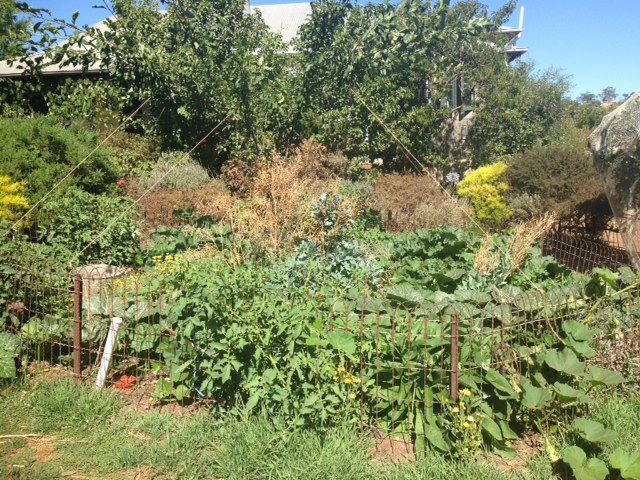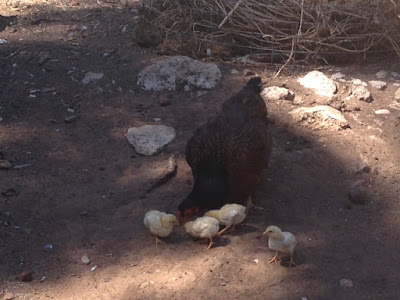I'm not winning! As fast as I get through all of the boxes of fruit, more keep arriving. My own fault as I can't bear to see anything wasted.
In a past life I owned a brand spanking new Fowlers Vacola Preserving outfit. Back then, newly married, in the seventies, every self respecting home manager (house wife) dutifully "put down" enough fruit and preserves to see the family through the coming year.
I gave my lovely, bright orange and yellow, Fowlers away many years ago when I traveled and lived overseas for a few years.
It seems ironic that I do more preserving now than I ever did, but without the proper equipment, and it's OK.
There are two methods that I use. Both are fast and easy, which suits my need to get things done with the least amount of effort.
It also requires less expense, which I'm all for these days. No need to replace those expensive rubber rings that are needed when using the Fowlers method. Nor do we need to buy all those expensive jars and lids.
If I had the Fowlers kit and all of the jars I would probably use them, but I never got around to buying a replacement set and now I don't think I ever will.
Granted, my jars don't look as attractive as the Fowlers, but really, no one is looking at them anyway and they still taste pretty .good.
I know that some people prefer to stew the fruit and place in containers in the freezer. I prefer not to be reliant on using the freezer to store my preserved fruit. Once the fruit is in the sealed jar there is no more added electricity expense in keeping it.
So, the first method is simply stewing the fruit on the stove top, and then spooning into recycled jars whilst hot. You can sweeten to your desire or use plain water and sweeten later if you think it is needed. Often the fruit becomes sweeter after it has been bottled for awhile.
Fill right to the top and screw the lid on tightly. The above picture is rhubarb stewed with some peaches. I'm poking the knife down the side edges to remove any air bubbles.
There is no cost involved in obtaining the jars, as friends happily pass on all of their used jars with metal lids. I don't sterilize the jars, but I do wash them well and store them in a clean dry area ready for use. The lids must be in good condition with the thin rubber ring in tact. Repeat... the lids must be metal.
It is important to stand the jars on a board or plate while filling. Do not stand on a marble or granite bench top. The stark difference in temperatures between the hot fruit inside the jar and the cold surface of the bench top will cause the jar to crack or break.
I usually stand the jar on a plate to catch the spilled juices while I'm filling it. Carefully spoon in the pieces of stewed fruit, wiggle the jar around to rid any air bubbles forming and to settle the fruit into the spaces. Spoon in the hot syrup in which the fruit has cooked. Fill the syrup right to the top of the jar. Run your finger around the rim of the jar to make sure nothing is obstructing the surface, then screw on the lid tightly.
Place your filled jars on a board or wooden table and wait for them to seal. You will hear the lids popping as they do so. It is much easier to use lids with the round raised bit in the middle, which are easy to see when they pop inwards.
Another positive that I love about preserving in this way is that we can preserve just one jar or many, depending on how much fruit we have on hand. It doesn't have to be a huge task that takes all day.
Method number two
I'm bottling a bit of everything in these jars today. There are Plumcots, Yellow Freestone Peaches, Nectarines, and I threw some Rhubarb into a few of the jars to add some interest.
I peeled the peaches, but left the skin on all of the other fruits. See how lazy I am? I didn't even remove the labels from these jars. The labels will fall off during the cooking process anyway.
So, this is the "water bath" method which is how it would be done if we were using the Fowlers jars.
You will need to make up a "syrup" to your taste. We can use any kind of sweetener, or plain water if preferred. I don't advocate artificial sweeteners of any kind, but many people do use them for making their "syrup".
Dissolve your preferred sweetener in a jug with a small amount of hot water, (white or brown sugar, golden syrup, coconut sugar, honey, rice malt syrup) then top up with cool water from the tap.
I use very little sugar or honey as I want the flavor of the fruit to shine above the sweetness.
Pile the raw fruit into the clean jars, packing it in tightly but not to make it squishy. Pack to half full, then pour in some of the syrup. At this point, wiggle the jar from side to side releasing any air bubbles. Then finish filling the jar with fruit before wiggling again, and pouring in more syrup to the very top of the jar leaving no space at all.
Sometimes I add a couple of Cardamom pods or seeds. Sometimes I add a piece of cinnamon stick or vanilla pod. There are no hard and fast rules, just go with your imagination.
Poke a knife down the edges to release any lurking air bubbles then screw on the lid tightly. Continue this process until you have enough jars to fill a large pot.
Stand the jars on a wire cake cooler to keep them off the bottom of the pot.
Pour in water to half way up the sides of the jars.
Put the lid on the large pot.
Bring to the boil on the stove top, then turn the temperature down and simmer for two hours.
After two hours turn off the heat.
Do not remove the lid of the pot until cool (or overnight) before lifting out the jars which should be sealed.
There are so many ways to use these jars of preserves; delicious straight out of the jar at any time, and especially in mid winter when fresh stone fruits are just a memory.
Next morning
The jars have all sealed beautifully. The one drawback with this water bath method is that the fruit rises to the top of the jars and seemingly wastes some space in each jar. This also happens when using the Fowlers jars and has to do with the amount of air that was trapped in the fruit and in between the pieces of the cut fruit. It has no effect on the quality or enjoyment of the eating though.So there you have two simple ways to preserve some of your glut without the need to buy expensive equipment.
Necessity is the mother of invention... or... there's usually more than one way to improvise.
These methods work well with fruit, but vegetables require more heat for longer times and they can be quite challenging, so I freeze any vegetables if I want to store them, except for preserving tomatoes in jars which I covered in this previous blog about preserving tomatoes..
Happy preserving!



















































